Glen Edward Taul
“Today I have not written a story I planned to write. This has taken one of our last days in time allotted to us to live. But John Preston has been worth every minute of it.”
Jesse Stuart[1]
As I traveled across W-Hollow toward Stuart’s home, there was an air of expectation. For many months I had been anticipating the moment when I would meet Jesse Stuart. The visit was the culmination of a connection begun through correspondence. On the day that Jesse Stuart welcomed me (aka John Preston) into his home, a serendipitous relationship evolved for both visitor and host. I wanted to understand him as a writer and establish a friendship with my favorite author of fiction. I had fantasized cursorily about being a character in one of his stories, but that was not my primary interest in meeting him. To my amazement though, I discovered first-hand how he was able to bring fictional characters, based on people he actually knew, to life and make them seem so real.
Stuart was an accomplished Appalachian author. I first read one of his books in high school. Mrs. Becker, my literature teacher, had given the assignment to choose a book by our favorite author and prepare to give an oral review. The problem was that I had never read any fiction outside of a textbook. When I told her of my dilemma, she suggested Stuart’s Taps for Private Tussie. I immediately liked it. It was funny and it was about the people of eastern Kentucky, which was from whence my mother came.
My interest in Stuart lay dormant until I entered graduate school in Texas. At the time of my visit with Stuart and his wife, Naomi, in 1975, I was working on a Master’s degree in American Studies. My American literature professor, E. Hudson Long, like my high school teacher, had given the assignment to pick an author and be prepared to make a presentation about the writer and his or her fiction. I had first chosen John Steinbeck, but on second thought I wanted to know more about Stuart. Dr. Long let me make the change. I selected six of Stuart’s books: Beyond Dark Hills, Trees of Heaven, Taps for Private Tussie, Foretaste of Glory, The Thread That Runs So True, and Hie to the Hunters.
Stuart is best known for Taps and The Thread That Runs So True. Taps was his most successful novel, selling more than a million copies when it was selected as a Book-of-the-Month Club® feature in 1943, and it won the Thomas Jefferson Award the same year.[2] The Thread That Runs So True is a semi-fictional story about a heroic teacher who teaches in a one-room school in rural Greenwood County, Kentucky, and later becomes superintendent of the county’s schools amidst the Great Depression. Beyond Dark Hills, Stuart’s first prose work, was written first as a term paper for his graduate class at Vanderbilt University. It is an autobiographical account of Stuart’s first twenty-one years in eastern Kentucky. Trees of Heaven, his first novel, tells the story of the conflict between two mountain families who represent different views of life—materialistic versus non-materialistic. Foretaste of Glory is an account of residents in a mountain community responding, often in comical ways, to the phenomenon of the aurora borealis which actually reached down to northeast Kentucky, Stuart’s home region, in 1941. Never experiencing such a sight, the residents of Blakesburg, Kentucky take the event as a portent for Christ’s second coming and for the end of the world.
My sixth choice, Hie to the Hunters, was my favorite. Ruel Foster classifies it as a minor novel of Stuart’s.[3] Hie to the Hunters is a story, reminiscent of Mark Twain’s classics, of a city kid, Didway “Did” Hargis (a Tom Sawyer-like character) learning about country life from Jud “Sparkie” Sparks (a Huckleberry-like character), who rescues Did one day from a beating by two bullies. Did accepts Sparkie’s invitation to live with him where Sparkie can protect him and teach him country ways. The two boys hunt, shoot, plow, trap, and do all other things country together. Did grows mentally tough and physically strong and embraces country life enthusiastically. A memorable scene is of the boys sleeping between fox hounds in a barn loft on cold winter days. The action in the novel is built around a conflict between town and hill people and a feud between tobacco growers and fox hunters. The town versus country clash is revealed whenever Did’s parents attempt, with the help of people from Greenwood, to compel Did to return to them. The most comical scene is a mass fight, the squabble’s climax, on a night when the people of Plum Grove are festively picking and shucking the year’s corn crop. The Plum Grove people, defending Did’s choice to stay, defeat Greenwood.
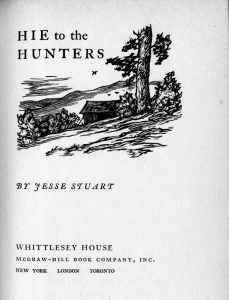
Title Page for Hie to the Hunters
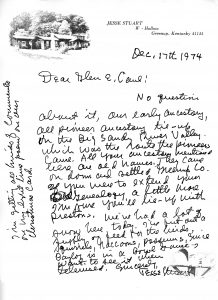 At the same time, someone is pitting tobacco growers against fox hunters. Barns are mysteriously burned and fox hounds, prized possessions of rural mountain people, are poisoned. Each group suspects the other, and there is difficulty in finding a way to conciliate the two. The second climax in the novel comes when the barn in which Sparkie and Did sleep is burned. Eventually Sparkie and Did catch the barn-burner, “Brier-Patch Tom” Eversole, who confesses to burning the barns and to poisoning the dogs. So peace comes between town and country and between tobacco growers and fox hunters, and Did reconciles with his father. In the last scene of Hie to the Hunters, Sparkie decides that he will not attend school, but remain on the land to which he is attached. Did will return to high school and graduate, but will eventually go back to the land which he came to love while living with Sparkie.
At the same time, someone is pitting tobacco growers against fox hunters. Barns are mysteriously burned and fox hounds, prized possessions of rural mountain people, are poisoned. Each group suspects the other, and there is difficulty in finding a way to conciliate the two. The second climax in the novel comes when the barn in which Sparkie and Did sleep is burned. Eventually Sparkie and Did catch the barn-burner, “Brier-Patch Tom” Eversole, who confesses to burning the barns and to poisoning the dogs. So peace comes between town and country and between tobacco growers and fox hunters, and Did reconciles with his father. In the last scene of Hie to the Hunters, Sparkie decides that he will not attend school, but remain on the land to which he is attached. Did will return to high school and graduate, but will eventually go back to the land which he came to love while living with Sparkie.
At the suggestion of Dr. Long, I began corresponding with Stuart. Stuart readily wrote back as if cultivating a disciple. His handwriting was bold, evoking an aura of vigor and effusiveness. There was an openness and an inviting spirit about the letters. They became a conversation exploring mutual interests. Stuart’s interest was heightened when I told him about my mother coming from Johnson County, Kentucky. “What interested me in your letter your ancestors had come from Paintsville, Ky My grandfather, father of my mother, Nathan Hilton was born in Paintsville . . . . My father’s mother Cynthia Meade was born there . . . . The pioneer Preston Cemetery, is filled with my kindred dead. I’m descended from the Prestons. . . . This is the land of your ancestors and mine.”[4] In response I told him that I was descended from the oldest pioneer families of the Big Sandy Valley—Price, Preston, Ward, Meek, Daniel, Sellards, among others. Stuart replied, “No question about it, our early ancestory, all pioneer ancestory tie-up on the Big Sandy River Valley, which was the route the pioneers came. All your ancestory mentioned here are old names. . . . If you were to extend your Genealogy a little more I’m sure you’ll tie-up with Prestons.”[5] Many years later his assertion was proven. Both of us are descendants of Moses Preston, Sr., a veteran of the Revolutionary War, and Fanny Arthur, who settled in Lawrence County, Kentucky, in 1800. Stuart descends from Preston’s oldest child, Susannah (Suka) while I descend from his fourth child, Linda (Lynchie).[6]
After a few exchanges of letters, I asked Stuart about the possibility of visiting him. I proposed to visit during my annual pilgrimage back to Kentucky to visit my grandparents. When I arrived on a hot August day, I was expecting to spend only an hour or two with him and Mrs. Stuart, but ended up staying for five. We had engaging conversations. He showed me his home, downtown Greenup, and places where the action of his stories happened. He treated me to lunch at Greenbo Lake State Resort Park, where I ate catfish for the first time. Before departing I gave him a jar of my uncle Dallas Taul’s honey. He gave me a signed copy of his latest novel, The Land Beyond the River.[7]
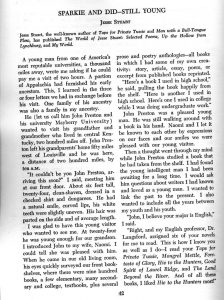 Sometime later Stuart informed me that he had written an “article-story” about my visit. “I changed some names, school and yours, to make it semi-fiction—however, it isn’t—and this piece was accepted last week by The Ball State University Forum. . . .”[8] When the story was published in 1980, it was entitled “Sparkie and Did—Still Young”.
Sometime later Stuart informed me that he had written an “article-story” about my visit. “I changed some names, school and yours, to make it semi-fiction—however, it isn’t—and this piece was accepted last week by The Ball State University Forum. . . .”[8] When the story was published in 1980, it was entitled “Sparkie and Did—Still Young”.
Writers, whether artisans of stories, poems, songs, or drama, approach their craft according to what works for them. The elements, however, are the same. They include a mix of observation, memory, imagination, and creativity. The material used in their work comes from witnessing and encountering people engaging daily with life, from the culture they know, from the traditions of the past, from the present. These artisans absorb their environment and store the experiences in their memories until their imaginations make connections to create a story.
Stuart’s stories are not plot driven. Unlike Henry James, he is not the consummate practitioner of the well crafted novel. Except for a few notes, he never begins a book by outlining it. He writes intuitively. His stories “have a kind of subconscious plot,” writes Foster. Stuart “has some image, some ‘hunch,’ some node of interest in his own mind which is the real subject matter”[9] of a story. Stuart implied this in his letter to me of March 1, 1976 when he says that he wrote it the day after my visit. It sounded as if it were almost spontaneous. Near the end of my visit, Mrs. Stuart showed me his work area, which was on the second floor of the last addition built on his house in 1971. While Mrs. Stuart was showing me his desk, I asked:
“When does he write?”
“It depends a lot on his mood,” she said. “When he starts, he will work until he finishes.”[10]
While the activities during my visit provided the framework of “Sparkie and Did—Still Young,” my interest in Hie to the Hunters was the principal motif. “Let us call him John Preston and his university Mayberry University. . . .”[11] Preston was chosen, of course, because of our common family lineage in the Big Sandy Valley. “Mayberry University” was the fictional name of Baylor University, where I was attending at the time, and Dr. Long appeared as “Dr. Langsford.”
From the moment I shook Stuart’s hand, he was absorbing everything about me. Before escorting me into his house, he took measure of me, physically putting his six-foot four-inch frame beside my six-foot form. He described Preston in the story as “about six feet tall, twenty-four, clean-shaven, dressed in a checked shirt and dungarees. He had a natural smile, curved lips, his white teeth were slightly uneven. His hair was parted on the side and of average length.”[12] When we entered his house, after being introduced to Mrs. Stuart, I was captivated by walls and walls of books, even in the living room. I did not sit immediately, going instead to the shelves in the “old living room” to see what he had. When a book caught my attention, I took it and browsed through the pages. This part of the house was a log cabin once, dating from 1820.[13]
“‘Would you like to sit down, John?’ Naomi asked him.
“‘No, not particularly,’ he said. ‘I’d like to look around this house. That is if you have more books!’”[14]
We eventually sat under the original low ceiling to begin my visit. The room invited reading and conversation. The low ceiling, the rough log walls, and sofas and chairs arranged in a half-circle facing a stone fire place created an ambience of hospitality, comfort, and intimacy.
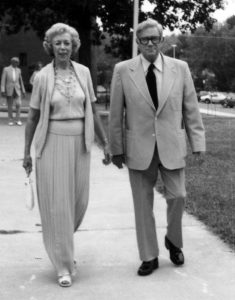
They continued to show me the rooms downstairs. As we moved slowly from room to room, we talked as I looked at books. We eventually began talking about the characters—Sparkie, Did, Peg, and Arn—in Hie to the Hunters. Although it had been a year since I had completed my assignment for Dr. Long, they were still alive in my imagination. Did, the city boy, went on an adventure into the rural part of his county with a country boy, Sparkie, who had saved him from a thrashing by two bullies. I identified with Did and yearned, even at age twenty-four, to experience the life that Sparkie represented. I had tasted country life during my adolescent years while visiting, for long periods, my paternal grandparents on their farm in western Kentucky. I had participated in many of the same activities as Did—hunting squirrels and rabbits with my dad, cousins, and uncles during Thanksgiving, stripping tobacco on a cold fall day, riding the tractor with my grandfather as he prepared the ground to plant corn, feeding hay to cattle in the barn during winter, collecting eggs from the hen house, and plucking feathers from just scalded chicken carcasses. I could even imagine myself sleeping in a hay loft between two blood hounds, like Did and Sparkie, on a cold winter’s night. There were two rooms in my grandparents’ one hundred-year-old, wood-framed house that lacked insulation. Sometimes my brother and I slept in the attic room covered with layers of blankets and quilts, lying near each other for warmth. In the mornings, after a fire was well under way in the kitchen’s wood stove, we quickly lowered the retractable stairs and scurried down to get warm before changing clothes.
I saw Sparkie and Did as fictional characters, but Stuart had drawn them from people he knew. Sparkie, according to H. Edward Richardson, was based on Jack Dysard, a colorful man who had a reputation in Plum Grove as being “‘the gun man and the razor man.’” He had been expelled from grade school for carrying a pistol.[15] Preston thought Sparkie was a great character, and mused that he was younger than him. Stuart stopped Preston in his tracks when he said that, “‘Even characters in the flesh grow and die like the rest of us.’” Sparkie had grown old and died and was buried at Plum Grove cemetery. Like Preston, I must have had a shocked expression on my face. Stuart records that Preston “was silenced;”[16] amazed that the real Sparkie was dead.
As in his other novels, Stuart drew on real people as the sources for his stories. In his best literary work, Stuart takes the material from the environment in which he had been immersed for his entire life. Richardson states, in his essay “Stuart Country”, that as a novelist Stuart fictionalized his community of W-Hollow. Stuart drew upon it repeatedly, adapting and transforming his sources as he moved them through generations and the present. He imbued this raw material with local color, characters, and events, and in the process, expanded, embellished, and eventually unified the whole, re-creating his world in miniature.[17]
After showing me (aka Preston) the rest of their home on the lower floor, they took me to the Jesse Stuart Lodge at Greenbo Lake State Resort Park for lunch.[18] On the way there, Stuart drove a route which went past or near sites related to the story of Sparkie and Did. When the Stuarts and John Preston reach the intersection of W-Hollow Road and State Route One, Stuart explains that they were at the beginning of the Plum Grove Hills, “the real setting for Hie to the Hunters. . . .” Stuart stopped on that spot long enough to point out the Plum Grove Church on top of a nearby hill. He said there are two cemeteries at the church. In the old one lies buried Stuart’s father, mother, two brothers, and “other kin”. In the newer one lies Sparkie. At this point in the story about Preston, Stuart reminds the reader of the principal motif of this story. He has Preston saying:
“‘I can’t believe Sparkie is dead,’ he spoke with a lamenting tone. ‘To me he will always be alive and young.’”
“‘Remember him that way,’”[19] Stuart said.
As they travel south on State Route One, Stuart pointed out the woods where Peg and Arn Sparks were buried, their graves most likely not marked. He remarked that Did and Sparkie once hunted among those trees. A little farther, after dropping over Barney Tunnel Hill, Stuart slows to show Preston a seldom used, one lane road to the right that Sparkie and Did once walked. Preston could see the oak grove where Peg and Arn’s house was located, and beside it was the barn in which Sparkie and Did lived. To his left, at the same place, was an area that was once known as Buzzards’ Roost. In Hie to the Hunters, this was Sparkie’s favorite place to go and listen to “my hounds drive home the fox!” It was the country way of fox hunting. During evenings, whether summer or winter, mountaineers would turn loose their prized hound dogs to run the foxes. “This ridge road is the home of the fox hunters. Here’s where we come to hear the chases. Ye can come here at night and listen to the hounds after the fox, . . .” Sparkie said. The fox chase is a competition, like a horse race, except the spectators follow the race with their ears rather than their eyes. They know each dog’s personality and competitive style. They know the terrain. Each dog strategizes to win against his opponents to win.
‘“Listen,’ Sparkie held up his hand, ‘I hear them comin’.’
“The hounds broke into music as they came around the east point of the mountain toward Buzzard Roost Ridge. Brierpatch Tom’s War Horse was back in the lead. Thunderbolt was back in the pack and Lightning was no longer in the chase.
‘“Lightnin’ ran only one circle tonight,’ Did apologized to Pollie.
‘“One long or two short circles is all old Lightnin’ ever runs,’ Sparkie interrupted. ‘That’s enough to bust the hounds that try to stay with ‘im. Thunderbolt understands. He waits until Lightnin’ is out of the chase. Lightnin’ is on his way to the fire now and Thunderbolt is pullin’ up to take the lead. Hear ‘im! Hear his bark!’
‘“Think of hounds runnin’ all night fightin’ just to lead the chase,’ Lucy said. ‘And then they never do ketch the fox!’” [20]
It was a part of Appalachian life that was confirmed for me when I visited my mother’s only sister in Wyoming County, West Virginia for a family reunion. In the rear of their house, four hounds were tethered in front of their dog houses. My uncle Claude said he and his neighbors would release their hounds into the surrounding hills during evenings to chase foxes. They could monitor the progress of the chase by each dog’s distinctive bark.
In 1975 Didway Hargis was still alive, though Stuart did not reveal his actual name. Stuart told Preston that Did returned to visit a sister and two brothers once a year. He made it a point to visit Stuart. They were close from the years they grew up together. They were like brothers.
As they proceed to their lunch destination, Stuart points out more sites of Sparkie’s and Did’s adventures. There was Tom Fitch’s store “where they sold their pelts and bought their supplies.”[21] And the station high on a hill where Sparkie and Did flagged trains to stop so they could ship the pelts of the animals they had trapped. Over here to the right was Sleepy Hollow which flows down to the Little Sandy River at Putt-Off Ford. At this place people were baptized in the spring (think of the scene in “O Brother, Where Art Thou?”) after the winter ice had thawed. In the first third of the twentieth century, baptizings were common events in the Sandy River all the way to Hopewell (about a sixteen-mile stretch), Mrs. Stuart tells Preston. Stuart says that every time he went to a baptizing as a boy, Sparkie (Jack Dysard) was always there. After they became friends, Jack took Did along, who never missed a one.
Stuart omitted one anecdote in his story, “Sparkie and Did—Still Young”. The experience was an insight into how he collected material for his stories. After finishing our catfish luncheon, they took me to Greenup, the county seat of Greenup County, and showed me around. There was the courthouse built with Works Progress Administration funds during the 1930s, and the granite shaft erected in 1955 in honor of Stuart for “Jesse Hilton Stuart Day in Kentucky” on the courthouse’s lawn. Stuart’s favorite spot, however, was Leslie’s Drug Store, across the street from the courthouse. [22] We walked to the middle of the store where I stood for a moment. Then I started to move over to the display of his books. I had taken only one step when Stuart took hold of my arm and said, “Stand right here. Look around. Absorb what is going on. Don’t be in such a hurry.” So I did.
We returned to his house and finished the day with a tour of the upstairs and his work space.[23] Stuart ends the story of “Sparkie and Did—Still Young” by expressing his amazement that Preston thought Hie to the Hunters was the best of his novels and the one that he had enjoyed the most. “I did not think Hie to the Hunters was my best novel but he did.” “All the characters in that book for him are alive and breathing.”[24]
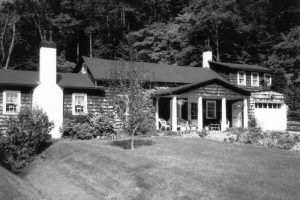
Stuart’s style of storytelling was not research based. He did not take a story idea and then do background research on situations, circumstances, or time periods. His writing was intuitive, impulsive, and intense, drawing directly from his world as he had observed and experienced it. He had a dynamic curiosity of people and their environment. Throughout this story about my interest in Sparkie and Did, he used elements of my background and of his life and career to frame the story’s principal motif. When I arrived that day, Stuart had not expected to write a story. When he encountered an experience or experiences that strongly affected him, he was compelled to write them down immediately. His whole being was invested in characters living in his world. He took elements of their lives and brought them to life with timeless qualities.
[1] Jesse Stuart, “Sparkie and Did–Still Young,” Forum, XXI, No. 2 (April 1980):42.
[2] Ruel E. Foster, Jesse Stuart (New York: Twayne Publishers, 1968), 103; Lisle Brown, Taps for Private Tussie, Jesse Stuart Collection of First Editions, Special Collections, Marshall University, [on-line exhibit]; available from http://www.marshall.edu/library/speccoll/virtual_museum/stuart/novels.asp; Internet; accessed March 8, 2014.
[3] Foster, Jesse Stuart, pp. 132-38; H. Edward Richardson, Jesse: The Biography of an American Writer, Jesse Hilton Stuart (New York: McGraw-Hill, 1984), p. 338.
[4] Jesse Stuart to Glen Edward Taul, October 22, 1974.
[5] Jesse Stuart to Glen E. Taul, December 17, 1974.
[6] Childers Family Reunion Historical Preservation Committee, Moses Preston and Fanny Arthur Family of Eastern Kentucky: The History of our Preston Family, 5 vols., (N.p., 2006), 50, 885.
[7] Glen Edward Taul, Diary of Glen Edward Taul, August 22, 1975.
[8] Jesse Stuart to Glen Edward Taul, March 1, 1976. For anyone interested in reading the story, the issue of the Forum, which has it, can be accessed at this web link of Ball State University: http://libx.bsu.edu/cdm/singleitem/collection/frm/id/26/rec/71. The story begins on page 42.
[9] Foster, Jesse Stuart, p. 91.
[10] Taul, Diary, August 22, 1975.
[11] Stuart, “Sparkie and Did—Still Young,” p. 42.
[12] Ibid.
[13] Taul, Diary, August 22, 1975; H. Edward Richardson, “Stuart Country: The Man-Artist and the Myth,” in Jesse Stuart: Essays on His Work, J.R. LeMaster and Mary Washington Clarke, eds. (Lexington: University Press of Kentucky, 1977), 5.
[14] Stuart, “Sparkie and Did—Still Young,” p. 43.
[15] Richardson, Jesse, pp. 60, 440.
[16] Stuart, “Sparkie and Did—Still Young,” p. 43.
[17] Richardson, “Stuart Country,” p. 2.
[18] Taul, Diary, August 22, 1975; Stuart, “Sparkie and Did—Still Young,” p. 45-46.
[19] Stuart, “Sparkie and Did—Still Young,” p. 44.
[20] Idem, Hie to the Hunters (New York: Whittlesey House, McGraw-Hill, 1950), pp. 76, 142.
[21] Stuart, “Sparkie and Did—Still Young,” p. 45.
[22] Richardson, Jesse, pp. 365-66; Taul, Diary, August 22, 1975.
[23] Taul, Diary, August 22, 1975.
[24] Stuart, “Sparkie and Did—Still Young,” p. 46, 47.
Glen Edward Taul is Archivist for Campbellsville University. He is the author of many articles related to Kentucky and Appalachian history. Taul holds a Ph.D. in American history from the University of Kentucky. He is Editor of The Campbellsville Review
